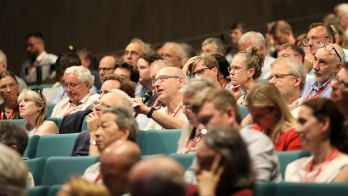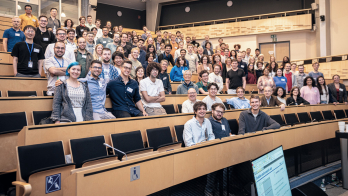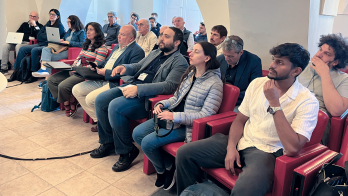First beam in the superconducting linac marks a fine start for TRIUMF’s new flagship facility.
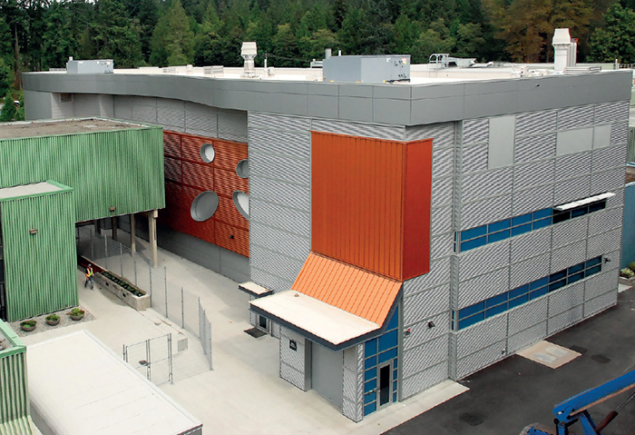
TRIUMF is Canada’s national laboratory for particle and nuclear physics, located in Vancouver. Founded in 1968, the laboratory’s particle-accelerator-driven research has grown from nuclear and particle physics to include vibrant programmes in materials science, nuclear medicine and accelerator science, while maintaining strong particle-physics activities elsewhere, for example at CERN and the Japan Proton Accelerator Research Complex. Currently, the laboratory’s flagship on-site programme uses rare-isotope beams (RIBs) for both discovery and application in the physical and health sciences.
Rare isotopes are not found in nature, yet they have properties that have shaped the evolution of the universe in fundamental ways, from powering the burning of stars to generating the chemical elements that make up life on Earth. These isotopes are foundational for modern medical-imaging techniques, such as positron-emission tomography and single-photon emission computed tomography, and are useful for therapeutic purposes, including the treatment of cancer tumours. They are also powerful tools for scientific discovery, for example in determining the structure and dynamics of atomic nuclei, understanding the processes by which heavy elements in the universe were created, enabling precision tests of fundamental symmetries that could challenge the Standard Model of particle physics, and serving as probes of the interfaces between materials.
TRIUMF’s Isotope Separator and Accelerator – ISAC – is one of the world’s premier RIB facilities. ISAC’s high proton-beam power (up to 50 kW) that produces the rare isotopes, its chain of accelerators that propels them up to energies of 6–18 MeV per nucleon for heavy and light-mass beams, respectively, and its experimental equipment that measures their properties are unmatched in the world.

All image credits: TRIUMF.
The Advanced Rare IsotopE Laboratory (ARIEL) was conceived to expand these capabilities in important new directions, and to establish TRIUMF as a world-leading laboratory in accelerator technology and in rare-isotope research for science, medicine and business. To expand the number and scope of RIBs feeding TRIUMF’s experimental facilities, ARIEL will add two high-power driver beams – one electron and one proton – and two new isotope production-target and transport systems.
Together with the existing ISAC station, the two additional target stations will triple the current isotope-production capacity, enable full utilization of the existing experimental facilities, and satisfy researcher demand for isotopes used in nuclear astrophysics, fundamental nuclear studies and searches for new particle physics, as well as in characterizing materials and in medical-isotope research. In addition, ARIEL will deliver important social and economic impacts, in the production of medical isotopes for targeted cancer therapy, in the characterization of novel materials, and in the continued advancement of accelerator technology in Canada, both at the laboratory and in partnership with industry.
The e-linac
ARIEL-I, the first stage of ARIEL, was funded in 2010 by the Canada Foundation for Innovation (CFI), the British Columbia Knowledge Development Fund, and the Canadian government. It comprises the ARIEL building (figure 1), completed in 2013, and a 25 MeV, 100 kW superconducting radio-frequency (SRF) electron linear accelerator (e-linac), which is the first stage of a new electron driver designed ultimately to achieve 50 MeV and 500 kW for the production of radioactive beams via photo-fission.
The ARIEL-I e-linac accelerated its first beam to 23 MeV in September 2014
The ARIEL-I e-linac, which accelerated its first beam to 23 MeV in September 2014, is a state-of-the-art accelerator featuring a number of technological breakthroughs (figure 2). The 10 mA continuous wave (cw) electron beam is generated in a 300 kV DC thermionic gridded-cathode assembly modulated at 650 MHz, bunched by a room-temperature 1.3 GHz RF structure, and accelerated using up to five 1.3 GHz superconducting cavities, housed in one 10 MeV injector cryomodule (ICM) and two accelerator cryomodules, each providing 20 MeV energy gain.
The design and layout of the e-linac are compatible with a future recirculation arc that can be tuned either for energy-recovery or energy-doubling operation. The electron source, designed and constructed at TRIUMF, exhibits reduced field-emission and a novel modulation scheme: the RF power is transmitted via a ceramic waveguide between the grounded vessel and the gun, so the amplifier is at ground potential. The source has been successfully tested to the full current specification of 10 mA cw. Specially designed short quadrupoles (figure 3) present minimum electron-beam aberrations by shaping the poles to be locally spherical, with radius 4π times the aperture radius (Baartman 2012).

The injector and accelerator cryomodules house the SRF cavities (figure 4), which are cooled to 2K and each driven by a 300 kW klystron. To take advantage of prior developments – and to contribute to future projects – TRIUMF chose the 1.3 GHz technology, the same as other global accelerator projects including the XFEL in Hamburg, the LCLS-II at SLAC, and the proposed International Linear Collider.
Through technology transfer from TRIUMF, the Canadian company PAVAC Industries Inc. fabricated the niobium cavities and TRIUMF constructed the cryomodules, based on the ISAC top-loading design (figure 2). The TRIUMF/PAVAC collaboration, which goes back to 2005, was born from the vision of “made in Canada” superconducting accelerators. Now, 10 years later, the relationship is a glowing example of a positive partnership between industry and a research institute.
International partnerships have been essential in facilitating technical developments for the e-linac. In 2008, TRIUMF went into partnership with the Variable Energy Cyclotron Centre (VECC) in Kolkata, for joint development of the ICM and the construction of two of them: one for ARIEL and one for ANURIB, India’s next-generation RIB facility, which is being constructed in Kolkata. In 2013, the collaboration was extended to include the development of components for ARIEL’s next phase, ARIEL-II. In addition, collaborations with Fermilab, the Helmholtz Zentrum Berlin and DESY were indispensable for the project.
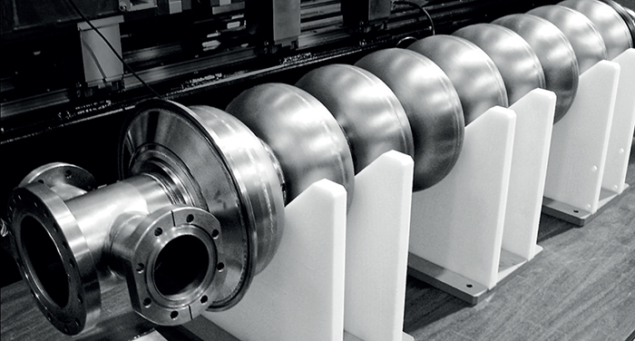
ARIEL’s development is continuing with ARIEL-II, which will complete the e-linac and add the new proton driver, production targets and transport systems in preparation for first science in 2017. Funding for ARIEL-II has been requested from the CFI on behalf of 19 universities, led by the University of Victoria, and matching funds are being sought from five Canadian provinces.
ARIEL will bring unprecedented capabilities:
•The multi-user RIB capability will not only triple the RIB hours delivered to users, but also increase the richness of the science by enabling long-running experiments for fundamental symmetries that are not practical currently.
•Photo-fission will allow the production of very neutron-rich isotopes at unprecedented intensities for precision studies of r-process nuclei.
•The multi-user capability will establish depth-resolved β-detected NMR as a user facility, unique in the world.
•High production rates of novel alpha-emitting heavy nuclei will accelerate development of targeted alpha tumour therapy.
The new facility will also provide important societal benefits. In addition to the economic benefits from the commercialization of accelerator technologies (e.g. PAVAC), ARIEL will expand TRIUMF’s outstanding record in student development through participation in international collaborations and training in advanced instrumentation and accelerator technologies. The e-linac has provided the impetus to form Canada’s first graduate programme in accelerator physics. One of only a few worldwide, the programme is in high demand globally and has already produced award-winning graduates.
ARIEL is not only the future of TRIUMF, it also embodies the mission of TRIUMF at large: scientific excellence, societal impact, and economic benefit. And it is off to a great start.






